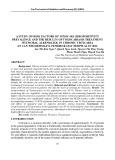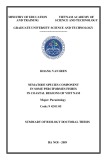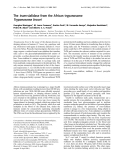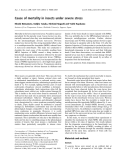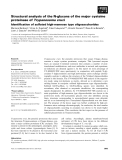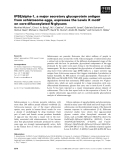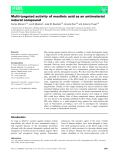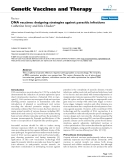
Parasitic infection
-
Chronic urticaria (CU) is defined by recurrent episodes lasting for six weeks or more and generally characterized by the sudden appearance of hives (wheal), angioedema or both. Most are idiopathic, however, one of the causes of chronic urticaria can be parasitic infection, especially Toxocariasis. Albendazol is used as a treatment for Toxocariasis.
 6p
6p  viakimichi
viakimichi
 17-01-2025
17-01-2025
 2
2
 2
2
 Download
Download
-
Thesis study of the composition of the parasitic nematodes in marine fishes in the off Vietnam is urgently needed. The survey’s results are not only provide the information about the fauna of fish’s nematoda, the relation between hosts-parasites, but also assess the the potential risks for human consumption.
 27p
27p  xacxuoc4321
xacxuoc4321
 08-07-2019
08-07-2019
 42
42
 6
6
 Download
Download
-
Trypanosoma brucei is the cause of the diseases known as sleeping sickness in humans (T. brucei ssp. gambiense and ssp. rhodesiense) and ngana in domestic animals (T. brucei brucei) in Africa. Procyclic trypomastigotes, the tsetse vector stage, express a surface-bound trans-sialidase that transfers sialic acid to the glycosylphosphatidylinositol anchor of procyclin, a surface glycoprotein covering the parasite surface. Trans-sialidase is a unique enzyme expressed by a few trypanosomatids that allows them to scavenge sialic acid from sialylated compounds present in the infected host. ...
 10p
10p  system191
system191
 01-06-2013
01-06-2013
 45
45
 4
4
 Download
Download
-
Mortality in the host armyworm larvaePseudaletia separata parasitized by the parasitic waspCotesia kariyaiwas dra-matically increased when they were simultaneously infected by the entomopathogen Serratia marcescens. Previous studies have shown that this strong insecticidal effect is due to a metalloprotease-like insecticide (MPLI)released from S. marcescensenterobacter. This study was conducted to elucidate the exact cause of the mortality resulting from MPLI.
 8p
8p  tumor12
tumor12
 20-04-2013
20-04-2013
 41
41
 1
1
 Download
Download
-
Trypanosoma cruzi, the parasitic protozoan that causes Chagas disease, contains a major cysteine proteinase, cruzipain. This lysosomal enzyme bears an unusual C-terminal extension that contains a number of post-translational modifications, and most antibodies in natural and experimen-tal infections are directed against it. In this report we took advantage of UV-MALDI-TOF mass spectrometry in conjunction with peptide N-gly-cosidase F deglycosylation and high performance anion exchange chroma-tography analysis to address the structure of the N-linked oligosaccharides present in this domain. ...
 13p
13p  fptmusic
fptmusic
 11-04-2013
11-04-2013
 43
43
 2
2
 Download
Download
-
Schistosomes are parasitic flatworms that infect millions of people in (sub)tropical areas around the world. Glycoconjugates of schistosomes play a critical role in the interaction of the different developmental stages of the parasite with the host. In particular, glycosylated components of the eggs produced by the adult worm pairs living in the bloodstream are strongly immunogenic.
 17p
17p  inspiron33
inspiron33
 26-03-2013
26-03-2013
 47
47
 3
3
 Download
Download
-
Most drugs against malaria that are available or under development target a single process of the parasite infective cycle, favouring the appearance of resistant mutants which are easily spread in areas under chemotherapeutic treatments.
 11p
11p  cosis54
cosis54
 04-01-2013
04-01-2013
 33
33
 4
4
 Download
Download
-
Tuyển tập các báo cáo nghiên cứu về sinh học được đăng trên tạp chí sinh học Journal of Biology đề tài: DNA vaccines: designing strategies against parasitic infections
 0p
0p  toshiba20
toshiba20
 12-11-2011
12-11-2011
 44
44
 2
2
 Download
Download
-
Schistosomiasis is caused by digenetic blood trematodes. The three main species infecting humans are Schistosoma haematobium, S. japonicum, and S. mansoni. Two other species, more localized geographically, are S. mekongi and S. intercalatum. In addition, other species of schistosomes, which parasitize birds and mammals, can cause cercarial dermatitis in humans.
 19p
19p  vohnongnguyen
vohnongnguyen
 23-03-2010
23-03-2010
 167
167
 6
6
 Download
Download
CHỦ ĐỀ BẠN MUỐN TÌM








